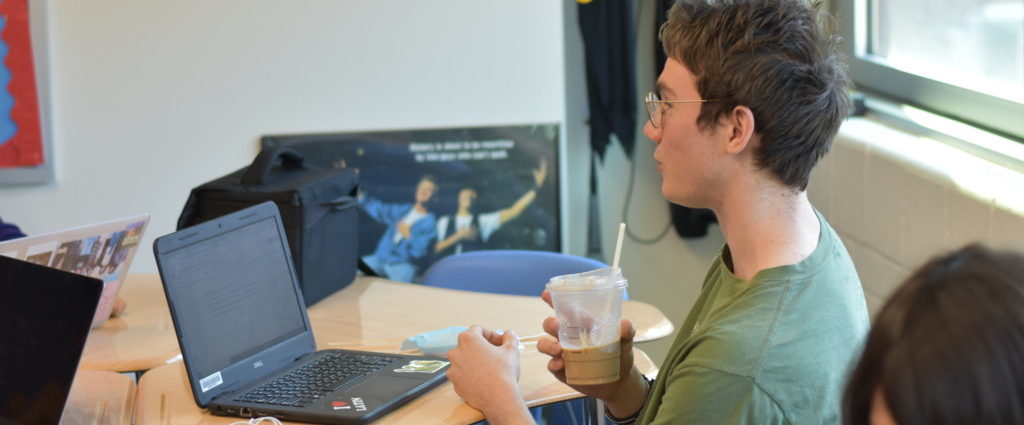Faculty Perspective
According to the Mayo Clinic, teenagers should be drinking a limit of 100 milligrams (8 ounces) of caffeine a day. However, some teenagers drink up to 800 milligrams daily.
Substance Abuse Prevention Specialist Allyson Jacobi said coffee is considered a psychoactive drug.
“Because caffeine produces the feeling of alertness, it is classified as a stimulant,” Jacobi said. “Most stimulants have no medical use in the U.S. but have high potential for addiction, which are classified or controlled as drugs.”
Jacobi said caffeine speeds up messages between the brain and the body.
“Caffeine enhances dopamine signaling in the brain,” she said. “Therefore, a common use is to help students feel a heightened awareness, more awake, and to provide a boost of energy.”
Health and physical education teacher Ryan Wood said caffeine is partially responsible for a larger problem with students’ sleeping habits.
“I will say that sleep is definitely an issue in today’s school system, and it’s a subject I talk about quite often with students,” Wood said. “A lot of students I speak with stay up until one or two in the morning doing school work, and it obviously has a multitude of dangerous impacts: hormonal [effects], mental health, blood pressure, etc.”
Wood raised concern about the attention paid to the issue.
“We seem to have a huge focus on every other factor contributing to mental health issues amongst teens except for one of the biggest drivers which is sleep deprivation,” he said.
With two kids and two jobs, Wood said he personally started to rely heavily on caffeine for energy.
“I actually just cut down because my caffeine intake got way too high, and it started to really affect my sleep and started to cause digestive issues,” he said. “At my peak within the past year, I was probably up to 600 milligrams in a day.”
Self-discipline allowed Wood to decrease his caffeine reliance, and his advice to students seeking to do the same is to get the sleep that they are using caffeine to prevent in the first place.
“Being tired due to lack of sleep is always going to cause more caffeine intake,” Wood said. “More caffeine intake will lead to even worse sleep, and the cycle continues.”


– senior Caitlin Golden
Student Perspective

– junior Shakira Akhter
Despite health concerns over teen caffeine consumption, students still drink it.
Some students see caffeine as a problem, others see it as a solution and others just like the taste.
Junior Sam Peden said he drinks three to six cups of coffee a day.
“School doesn’t really care about my schedule, and my other activities are pretty tiring, so if I want to have a prayer of getting stuff done, coffee helps a ton,” Peden said. “It’s not super healthy, but it is a tool.”
Even though he sees it as a useful tool, Peden said it becomes a problem when it interferes with his sleep.
“When I am using it to compensate for sleep, I can feel very disconnected,” Peden said. “I feel very delirious, and I’m always far from aware of what’s going on around me.”
Junior Arina Banks does not see caffeine as a problem. It has been a part of her life since late elementary school when she started drinking coffee.
“I would say [caffeine] definitely has had a positive impact,” Banks said. “For me, it’s not exactly so much an energy booster as it is a mood stabilizer—it just puts me in a state where I’m more ready for whatever comes at me that day.”
When Banks did a 23andMe test, it told her a healthy amount of caffeine her body can handle based on her genes. She uses this as a guide for how much she has daily.
“I drink, what is apparently genetically, the recommended amount of caffeine for me, which is three cups a day,” Banks said. “Sometimes that might be two cups depending on what mood I’m in or how much energy I have.”
The test results impact how much caffeine Banks drinks but so does her culture and school commitments.
“If I’m having dinner, I am European, so I typically have a cup of espresso,” Banks said. “But typically on the weekdays, I avoid that because I want to be able to get to bed at a reasonable time.”
Banks said drinking caffeine runs in her family.
“People in my family line have been alright drinking lots of caffeine, it hasn’t caused any sort of negative health effects.” Banks said. “For me personally, I’ve found that, because I’ve been drinking it from such a young age, I’ve just developed a strong tolerance to it, meaning I don’t get as affected by a single cup or two cups as some people do.”
Unlike Banks, sophomore Layan Albarghouthi’s culture dictated a stop to coffee when Ramadan began.
“I started cutting out all caffeine about two weeks before Ramadan started so that I could get used to life without it and I wouldn’t have to fast [with] all the withdrawal symptoms,” Albarghouthi said. “It was a personal decision to cut it out because last year, I didn’t do it, and I had the worst headaches in my life.”
Albarghouthi said her addiction to caffeine started in 2020 with a whipped coffee trend popular on TikTok. Since then, her habit has taken off and she has resorted to stronger beverages like energy drinks.
“It feels as if I’ve built up a tolerance to it, so I need to drink a lot of it for it to take effect and the most efficient way for me is energy drinks,” Albarghouthi said.
Albarghouthi’s parents had to intervene in order to limit intake of caffeine.
“[My parents] didn’t actually stop me until I started to drink energy drinks often. At that point they sorta realized I had an addiction, so they cut me off.”
For Albarghouthi, caffeine may not be the answer, but other students with different lifestyles see caffeine culture differently.

